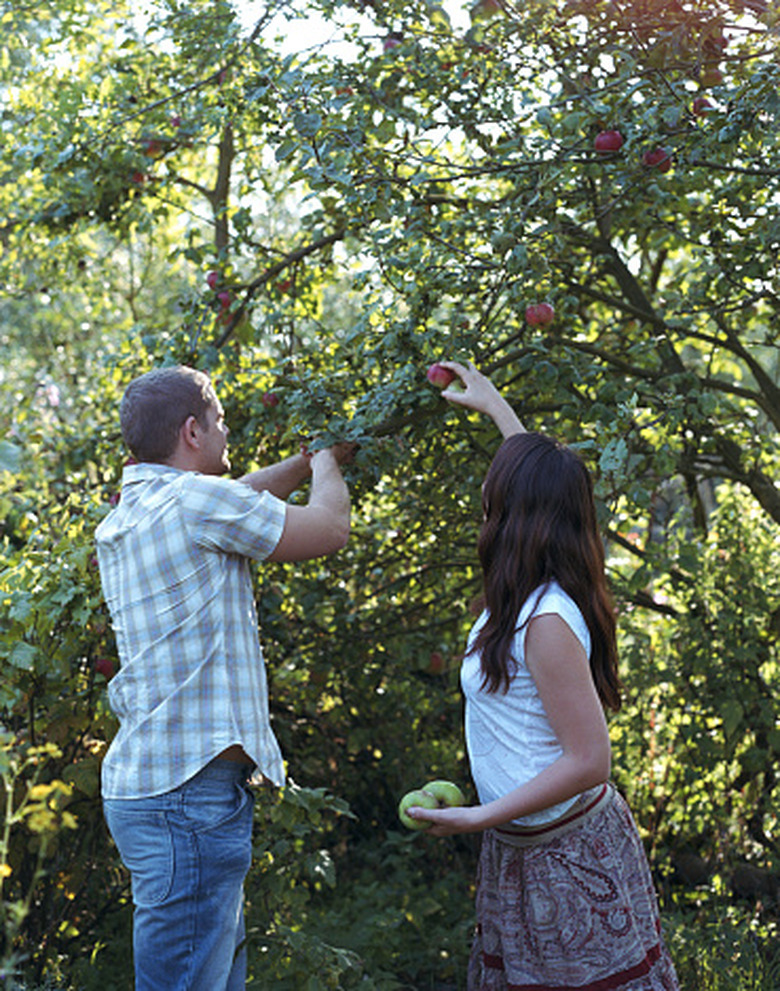How To Control Codling Moth On Apple Trees
Things Needed
- Trashcan
- Codling moth traps
- Phosmet-based insecticide
- Measuring tape
- Cardboard
- Heavy-duty duct tape
- Scissors
The codling moth is the inspiration for cartoons that depict an apple with a cutesy worm poking through it. In real life, the codling moth larva is a serious pest on apple, pear and English walnut trees. It chews its way to the fruit core or young walnut meats, making both fruits and nuts inedible; damaged nuts usually fall from the tree well before maturity. After it takes up residence inside, the codling moth larva lives in the fruit for three weeks, stuffing itself with the apple's flesh. Once it becomes an adult, it crawls back out into the world — falling off the tree before climbing up the tree trunk to form a cocoon and await transformation into a moth. Begin by controlling the codling moth with natural nontoxic options. If they fail, try synthetic chemicals.
- The codling moth is the inspiration for cartoons that depict an apple with a cutesy worm poking through it.
- After it takes up residence inside, the codling moth larva lives in the fruit for three weeks, stuffing itself with the apple's flesh.
Step 1
Examine your trees for signs of larvae holes weekly. If larvae are eating your apples or pears you'll see some crumbly brownish-red plant material — which the larvae excrete from their orifices as they digest fruit — around holes on fruit skin. Pick and discard all apples that appear infested to interrupt the moth's reproduction cycle. In addition, remove fallen fruit off the ground.
Step 2
Hang codling moth traps in the apple tree in early spring, to know when codling moths are active. Traps have pheromones — chemical substances that animals produce and release to attract a mate — that lure unsuspecting codling moths looking for romance. Once inside, the insects get stuck to the trap's sticky bottom. Use two traps per tree, and place them on the tree's highest branches. Scrape the dead moths off the trap bottoms once a week to keep the sticky area exposed. Replace the bottom with a new one every month.
- Examine your trees for signs of larvae holes weekly.
- If larvae are eating your apples or pears you'll see some crumbly brownish-red plant material — which the larvae excrete from their orifices as they digest fruit — around holes on fruit skin.
Step 3
Measure the tree trunk and branches, and cut pieces of corrugated cardboard the right size to wrap around them. Install the cardboard collars tightly around the tree's limbs and trunk in May or later (depending on the moth's life cycle in your area). Use heavy-duty duct tape to keep these covers in place. Don't staple them to the wood as other pests might find their way into the tree through the holes left. Unable to reach the bark, the codling moth larva will weave its cocoon on the cardboard. Once this happens, remove and discard the trunk and branch collars.
Step 4
Spray your apple tree with an insecticide that contains phosmet, if needed. Treat the plant with it every two weeks. Begin to spray two weeks after the pheromone trap catches its first moth.
- Measure the tree trunk and branches, and cut pieces of corrugated cardboard the right size to wrap around them.
- Install the cardboard collars tightly around the tree's limbs and trunk in May or later (depending on the moth's life cycle in your area).
Tip
Encourage birds, at least during larvae season, because they will pluck worms from tree bark and eat them enthusiastically. Traps work best for isolated apple, pear and walnut trees. Some early maturing varieties of apples and pears are resistant to codling moths, due to crop timing.
